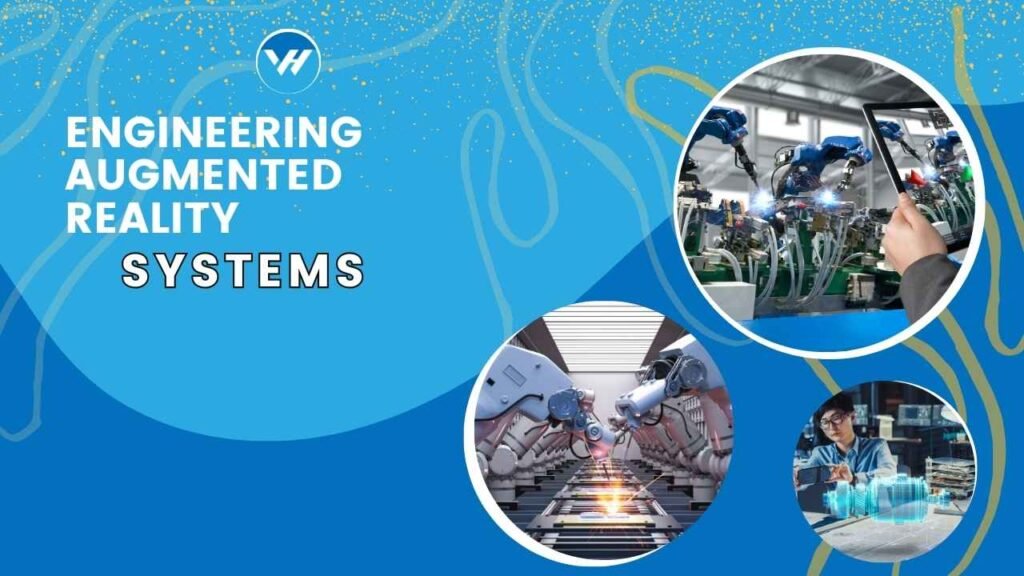Ever wondered what it’s like to see the world through a new lens? That’s what Augmented Reality (AR) does, especially in the engineering field. AR is revolutionizing how engineers design, build, and maintain systems. Let’s dive into the fascinating world of AR in engineering, where the line between the digital and physical worlds blurs.

Table of Contents
ToggleWhat is Augmented Reality?
Augmented Reality (AR) is a technology that overlays digital information—images, sounds, and other data—onto the real world. Unlike Virtual Reality (VR), which creates a completely immersive digital environment, AR enhances your existing surroundings with digital elements. Mixed Reality (MR) is another term you’ll hear, which combines elements of both AR and VR.
History of Augmented Reality
AR might seem like a futuristic concept, but its roots go back several decades. The first AR systems were developed in the late 20th century, with significant milestones like the creation of the first head-mounted display system in the 1960s and the development of ARToolKit in the late 1990s, which allowed for marker-based AR applications.
Applications of Augmented Reality in Engineering
AR in Design and Prototyping
Imagine designing a complex machine and being able to see a 3D model of it right in front of you, tweaking and adjusting parts as if they were real. That’s AR in design and prototyping, making the process faster and more intuitive.
AR in Maintenance and Repair
For maintenance and repair, AR can be a game-changer. Technicians can use AR glasses to see step-by-step instructions overlaid on the actual machinery, reducing errors and speeding up repairs.
AR in Construction
In construction, AR can help visualize buildings and structures before they are built, allowing for better planning and more accurate construction processes. This can prevent costly mistakes and improve overall project efficiency.
AR in Training and Education
Training engineers with AR provides a hands-on learning experience without the risk of handling real machinery. It’s like having a personal tutor guiding you through each step, making complex concepts easier to understand.
How Augmented Reality Works in Engineering
AR Hardware: Devices and Tools
To experience AR, you’ll need specific hardware. This includes AR glasses, like Microsoft HoloLens, or mobile devices equipped with AR capabilities. These devices project digital information onto physical objects, making the interaction seamless.
AR Software: Platforms and Applications
The software is where the magic happens. Platforms like Unity and Unreal Engine are used to create AR applications, while tools like Vuforia and ARKit help integrate AR into existing systems.
Benefits of Augmented Reality in Engineering
Enhanced Visualization
AR provides enhanced visualization, allowing engineers to see their projects in a more detailed and immersive way. This can lead to better design decisions and improved project outcomes.
Improved Accuracy and Precision
With AR, measurements and placements can be more precise, reducing the likelihood of errors and increasing the overall quality of the engineering work.
Increased Efficiency and Productivity
AR can streamline various processes, from design to maintenance, making engineering tasks quicker and more efficient. This can lead to significant time and cost savings.
Challenges of Implementing Augmented Reality in Engineering
Technical Challenges
Integrating AR into existing systems can be technically challenging. It requires robust hardware, sophisticated software, and a reliable internet connection to work effectively.
Cost and Investment
Implementing AR can be costly, especially for small firms. The initial investment in hardware and software can be high, and there are ongoing costs for maintenance and updates.
User Adoption and Training
Getting engineers and technicians to adopt AR technology can be a hurdle. It requires training and a shift in mindset to embrace new ways of working.
Future of Augmented Reality in Engineering
The future of AR in engineering looks promising. Emerging trends include more sophisticated AR applications, integration with AI and IoT, and increased use in remote collaboration. As technology advances, the possibilities for AR in engineering will continue to expand.
Virtual Help: Your Partner in Engineering AR Systems
Overview of Virtual Help
Virtual Help is an innovative platform that connects students and professionals with expert tutors and assignment help. With a user-friendly iOS and Android app, you can find the assistance you need to master AR systems and more.
How Virtual Help Can Assist with AR Systems
Whether you’re a student learning about AR or a professional looking to implement it in your projects, Virtual Help offers resources and expert guidance. From tutorials to one-on-one sessions, you can get the help you need to succeed.
How to Get Started with Augmented Reality in Engineering
Starting with AR in engineering involves a few key steps. Begin by researching AR technologies and identifying the ones that best fit your needs. Invest in the necessary hardware and software, and provide training for your team. Utilize resources like Virtual Help to get expert advice and support.
The Role of AR in Remote Collaboration
AR can greatly enhance remote collaboration by allowing engineers to work together in a shared digital space. This is especially useful for global teams, as it enables real-time collaboration and problem-solving.
Security and Privacy Concerns in AR Systems
With the integration of AR, security and privacy concerns must be addressed. Protecting data and intellectual property is crucial, and steps must be taken to ensure that sensitive information is secure. This includes using encryption and secure networks, as well as implementing strict access controls.
Integrating AR with Other Technologies
AR and IoT
Combining AR with the Internet of Things (IoT) allows for real-time data visualization from connected devices. This can improve monitoring and control of engineering systems.
AR and AI
Integrating AR with Artificial Intelligence (AI) can enhance the capabilities of AR applications. AI can analyze data and provide insights, making AR systems more intelligent and responsive.
Conclusion
Augmented Reality is transforming the engineering landscape, making processes more efficient, accurate, and immersive. As technology continues to evolve, the potential for AR in engineering is limitless. By leveraging platforms like Virtual Help, engineers can stay ahead of the curve and fully harness the power of AR.
FAQs
What is the difference between AR and VR?
Augmented Reality enhances the real world with digital elements, while Virtual Reality creates an entirely immersive digital environment.
How expensive is it to implement AR in engineering?
The cost can vary widely, but initial investments in AR hardware and software can be significant. However, the long-term benefits often outweigh the costs.
What are the main industries using AR in engineering?
Industries like automotive, aerospace, construction, and manufacturing are among the main adopters of AR in engineering.
How does AR improve training for engineers?
AR provides an interactive and hands-on learning experience, making complex concepts easier to understand and retain.
Is AR technology accessible for small engineering firms?
While initial costs can be high, there are affordable AR solutions available. Additionally, the long-term efficiency gains can make AR a worthwhile investment for small firms.





